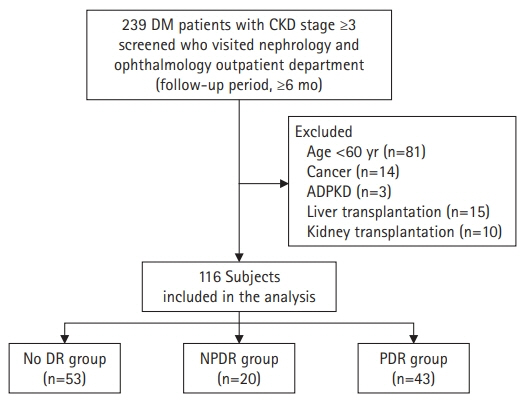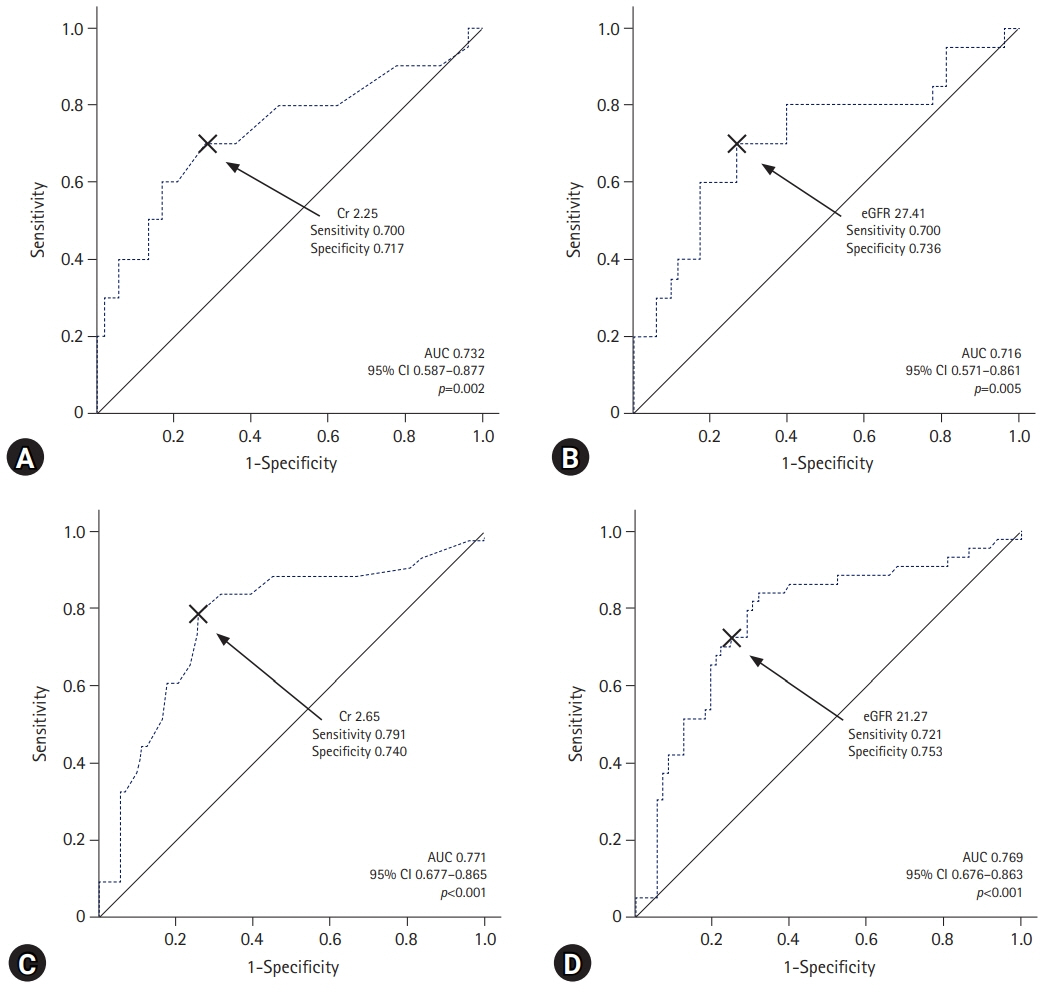J Yeungnam Med Sci.
2023 Apr;40(2):146-155. 10.12701/jyms.2022.00206.
Association of advanced chronic kidney disease with diabetic retinopathy severity in older patients with diabetes: a retrospective cross-sectional study
- Affiliations
-
- 1Department of Ophthalmology, Daegu Catholic University School of Medicine, Daegu, Korea
- 2Department of Thoracic and Cardiovascular Surgery, Daegu Catholic University School of Medicine, Daegu, Korea
- 3Division of Nephrology, Department of Internal Medicine, Daegu Catholic University School of Medicine, Daegu, Korea
- KMID: 2541940
- DOI: http://doi.org/10.12701/jyms.2022.00206
Abstract
- Background
Despite the recent increasing trend in the prevalence of type 2 diabetes among older individuals, the relationship between diabetic retinopathy (DR) and chronic kidney disease (CKD) in these patients remains unclear. This study investigated the severity of renal dysfunction according to the degree of DR in older patients with type 2 diabetes.
Methods
A total of 116 patients with diabetes and CKD stage ≥3 who visited both the nephrology and ophthalmology outpatient departments between July 2021 and January 2022 were screened. There were 53 patients in the no DR group, 20 in the nonproliferative DR (NPDR) group, and 43 in the proliferative DR (PDR) group.
Results
DR severity was related to the deterioration of renal function. The proportion of patients with advanced CKD significantly increased with DR severity (p for trend <0.001). In the multivariate regression model adjusted for age of ≥80 years, male sex, poorly controlled diabetes, macroalbuminuria, insulin use, diabetes duration of ≥10 years, cerebrovascular accident, hypertension, hyperlipidemia, and cardiovascular disease history, the odds ratio compared with the no DR group was approximately 4.6 for the NPDR group and approximately 11.8 for the PDR group, which were both statistically significant (p=0.025 and p<0.001, respectively).
Conclusion
DR severity in older patients with diabetes may be associated with deterioration of renal function and high prevalence of advanced CKD. Therefore, periodic examination for DR in older patients with diabetes is important for predicting renal function deterioration and CKD progression.
Figure
Reference
-
References
1. Klein R, Klein BE, Moss SE, Davis MD, DeMets DL. The Wisconsin epidemiologic study of diabetic retinopathy. III. Prevalence and risk of diabetic retinopathy when age at diagnosis is 30 or more years. Arch Ophthalmol. 1984; 102:527–32.2. Adler AI, Stevens RJ, Manley SE, Bilous RW, Cull CA, Holman RR, et al. Development and progression of nephropathy in type 2 diabetes: the United Kingdom Prospective Diabetes Study (UKPDS 64). Kidney Int. 2003; 63:225–32.3. Wolf G, Müller N, Mandecka A, Müller UA. Association of diabetic retinopathy and renal function in patients with types 1 and 2 diabetes mellitus. Clin Nephrol. 2007; 68:81–6.4. Penno G, Solini A, Zoppini G, Orsi E, Zerbini G, Trevisan R, et al. Rate and determinants of association between advanced retinopathy and chronic kidney disease in patients with type 2 diabetes: the Renal Insufficiency And Cardiovascular Events (RIACE) Italian multicenter study. Diabetes Care. 2012; 35:2317–23.5. Khan MA, Hashim MJ, King JK, Govender RD, Mustafa H, Al Kaabi J. Epidemiology of type 2 diabetes: global burden of disease and forecasted trends. J Epidemiol Glob Health. 2020; 10:107–11.6. Bellary S, Kyrou I, Brown JE, Bailey CJ. Type 2 diabetes mellitus in older adults: clinical considerations and management. Nat Rev Endocrinol. 2021; 17:534–48.7. Jung CH, Son JW, Kang S, Kim WJ, Kim HS, Kim HS, et al. Diabetes fact sheets in Korea, 2020: an appraisal of current status. Diabetes Metab J. 2021; 45:1–10.8. Lee PG, Halter JB. The pathophysiology of hyperglycemia in older adults: clinical considerations. Diabetes Care. 2017; 40:444–52.9. Grunwald JE, Pistilli M, Ying GS, Daniel E, Maguire M, Xie D, et al. Association between progression of retinopathy and concurrent progression of kidney disease: findings from the Chronic Renal Insufficiency Cohort (CRIC) Study. JAMA Ophthalmol. 2019; 137:767–74.10. Beard JR, Officer A, de Carvalho IA, Sadana R, Pot AM, Michel JP, et al. The world report on ageing and health: a policy framework for healthy ageing. Lancet. 2016; 387:2145–54.11. Levey AS, Stevens LA, Schmid CH, Zhang YL, Castro AF 3rd, Feldman HI, et al. A new equation to estimate glomerular filtration rate. Ann Intern Med. 2009; 150:604–12.12. Williams B, Mancia G, Spiering W, Agabiti Rosei E, Azizi M, Burnier M, et al. 2018 ESC/ESH guidelines for the management of arterial hypertension: the Task Force for the management of arterial hypertension of the European Society of Cardiology and the European Society of Hypertension: the Task Force for the management of arterial hypertension of the European Society of Cardiology and the European Society of Hypertension. J Hypertens. 2018; 36:1953–2041.13. Early Treatment Diabetic Retinopathy Study Research Group. Grading diabetic retinopathy from stereoscopic color fundus photographs: an extension of the modified Airlie House classification: ETDRS report number 10. Ophthalmology. 1991; 98(5 Suppl):786–806.14. Early Treatment Diabetic Retinopathy Study Research Group. Fundus photographic risk factors for progression of diabetic retinopathy: ETDRS report number 12. Ophthalmology. 1991; 98(5 Suppl):823–33.15. Baron RM, Kenny DA. The moderator-mediator variable distinction in social psychological research: conceptual, strategic, and statistical considerations. J Pers Soc Psychol. 1986; 51:1173–82.16. Mogensen CE, Christensen CK, Vittinghus E. The stages in diabetic renal disease: with emphasis on the stage of incipient diabetic nephropathy. Diabetes. 1983; 32(Suppl 2):64–78.17. Ibrahim HN, Hostetter TH. Diabetic nephropathy. J Am Soc Nephrol. 1997; 8:487–93.18. Diabetes Control and Complications Trial/Epidemiology of Diabetes Interventions and Complications Research Group, Lachin JM, Genuth S, Cleary P, Davis MD, Nathan DM. Retinopathy and nephropathy in patients with type 1 diabetes four years after a trial of intensive therapy. N Engl J Med. 2000; 342:381–9.19. Williams ME. Diabetic nephropathy: the proteinuria hypothesis. Am J Nephrol. 2005; 25:77–94.20. Lachin JM, Bebu I, Bergenstal RM, Pop-Busui R, Service FJ, Zinman B, et al. Association of glycemic variability in type 1 diabetes with progression of microvascular outcomes in the diabetes control and complications trial. Diabetes Care. 2017; 40:777–83.21. Palmberg P, Smith M, Waltman S, Krupin T, Singer P, Burgess D, et al. The natural history of retinopathy in insulin-dependent juvenile-onset diabetes. Ophthalmology. 1981; 88:613–8.22. Romero-Aroca P, Mendez-Marin I, Baget-Bernaldiz M, Fernéndez-Ballart J, Santos-Blanco E. Review of the relationship between renal and retinal microangiopathy in diabetes mellitus patients. Curr Diabetes Rev. 2010; 6:88–101.23. Park CW. Diabetic kidney disease: from epidemiology to clinical perspectives. Diabetes Metab J. 2014; 38:252–60.24. Brocco E, Fioretto P, Mauer M, Saller A, Carraro A, Frigato F, et al. Renal structure and function in non-insulin dependent diabetic patients with microalbuminuria. Kidney Int Suppl. 1997; 63:S40–4.25. Schwartz MM, Lewis EJ, Leonard-Martin T, Lewis JB, Batlle D. Renal pathology patterns in type II diabetes mellitus: relationship with retinopathy. The Collaborative Study Group. Nephrol Dial Transplant. 1998; 13:2547–52.26. Mather HM, Chaturvedi N, Kehely AM. Comparison of prevalence and risk factors for microalbuminuria in South Asians and Europeans with type 2 diabetes mellitus. Diabet Med. 1998; 15:672–7.27. Wu AY, Kong NC, de Leon FA, Pan CY, Tai TY, Yeung VT, et al. An alarmingly high prevalence of diabetic nephropathy in Asian type 2 diabetic patients: the MicroAlbuminuria Prevalence (MAP) Study. Diabetologia. 2005; 48:17–26.28. Mobasseri M, Shirmohammadi M, Amiri T, Vahed N, Hosseini Fard H, Ghojazadeh M. Prevalence and incidence of type 1 diabetes in the world: a systematic review and meta-analysis. Health Promot Perspect. 2020; 10:98–115.29. Cho NH, Shaw JE, Karuranga S, Huang Y, da Rocha Fernandes JD, Ohlrogge AW, et al. IDF Diabetes Atlas: global estimates of diabetes prevalence for 2017 and projections for 2045. Diabetes Res Clin Pract. 2018; 138:271–81.30. Kramer CK, Retnakaran R. Concordance of retinopathy and nephropathy over time in type 1 diabetes: an analysis of data from the Diabetes Control and Complications Trial. Diabet Med. 2013; 30:1333–41.31. Parving HH, Gall MA, Skøtt P, Jørgensen HE, Løkkegaard H, Jørgensen F, et al. Prevalence and causes of albuminuria in non-insulin-dependent diabetic patients. Kidney Int. 1992; 41:758–62.32. El-Asrar AM, Al-Rubeaan KA, Al-Amro SA, Moharram OA, Kangave D. Retinopathy as a predictor of other diabetic complications. Int Ophthalmol. 2001; 24:1–11.33. Jindal A, Garcia-Touza M, Jindal N, Whaley-Connell A, Sowers JR. Diabetic kidney disease and the cardiorenal syndrome: old disease, new perspectives. Endocrinol Metab Clin North Am. 2013; 42:789–808.34. Schmechel H, Heinrich U. Retinopathy and nephropathy in 772 insulin-treated diabetic patients in relation to the type of diabetes. Diabete Metab. 1993; 19(1 Pt 2):138–42.35. Romero Aroca P, Calviño Domínguez O, Del Castillo Dejàrdin D. Epidemiologic study of diabetic retinopathy in a primary care unit. Arch Soc Esp Oftalmol. 2000; 75:147–52.36. Cankurtaran V, Inanc M, Tekin K, Turgut F. Retinal microcirculation in predicting diabetic nephropathy in type 2 diabetic patients without retinopathy. Ophthalmologica. 2020; 243:271–9.37. da Silva MO, do Carmo Chaves AE, Gobbato GC, Dos Reis MA, Lavinsky F, Schaan BD, et al. Early neurovascular retinal changes detected by swept-source OCT in type 2 diabetes and association with diabetic kidney disease. Int J Retina Vitreous. 2021; 7:73.38. Alé-Chilet A, Bernal-Morales C, Barraso M, Hernández T, Oliva C, Vinagre I, et al. Optical coherence tomography angiography in type 1 diabetes mellitus-report 2: diabetic kidney disease. J Clin Med. 2021; 11:197.
- Full Text Links
- Actions
-
Cited
- CITED
-
- Close
- Share
- Similar articles
-
- Diagnosis and test for diabetic kidney disease
- The Association of Diabetic Neuropathy with Other Chronic Diabetic Complications
- Photopic Flash ERG Changes in Diabetic Retinopathy: with reference to severity of diabetic retinopathy
- The Influences of Arteriosclerosis on the Development and Progression of Diabetic Retinopathy
- The Relation of Microalbuminuria with Diabetic Retinopathy in Diabetic Patients without Proteinuria





